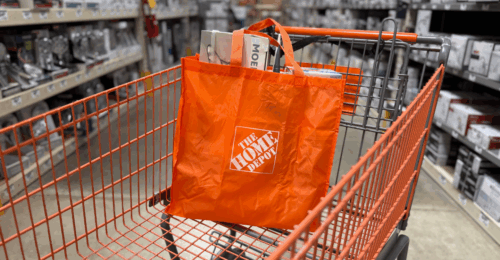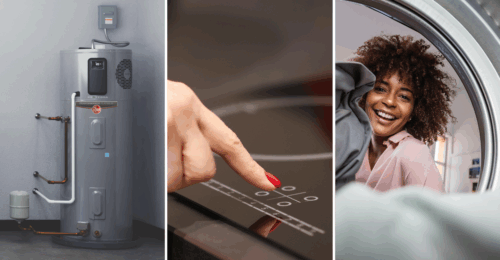Recently, The Home Depot was recognized by the U.S. Environmental Protection Agency (EPA) and the U.S. Department of Energy for our ongoing partnership with ENERGY STAR. For over a decade, The Home Depot has worked to promote energy efficiency at home through the use of ENERGY STAR-certified products, exceeding a multi-year goal to help customers save $2.8B on utility bills.
ENERGY STAR® Products Promote Energy Efficiency at Home
ENERGY STAR is a program managed by the EPA with the goal of promoting energy efficiency. The ENERGY STAR label was developed to provide standardization for energy-efficient products and solutions. Since 1992, it has been used by thousands of industrial, commercial, utility, state and local organizations – including retailers like The Home Depot and product manufacturers like GE, Samsung, LG, Rheem, Bosch and Andersen – to advance energy efficiency.
Thanks to ENERGY STAR and its partners, American families and businesses have saved 5T kilowatt-hours of electricity, avoided more than $500B in energy costs and achieved 4B metric tons of greenhouse gas reductions. At The Home Depot, ENERGY STAR products provide a simple choice for consumers who want to save energy for any reason, whether they are environmentally conscious or budget-conscious.

ENERGY STAR Product Certification
Products that display the ENERGY STAR label have been independently certified to meet the EPA’s strict criteria for energy efficiency. This certification has helped unite consumers, manufacturers, retailers, and utilities around metrics for energy use and saving, making it possible to differentiate between energy-efficient products. ENERGY STAR certification is administered by more than 20 independent certification organizations and over 500 labs. It is a rigorous, ongoing process meant to maintain integrity and public trust. Independent certification organizations perform pre-market and post-market testing, pulling products off the shelf of retailers to ensure compliance.
The cumulative effect is enormous. In 2020 alone, ENERGY STAR-certified products helped consumers save:
- 240B kilowatt-hours of electricity
- $24B in energy costs
- 180M metric tons of greenhouse gas emissions
A Room-by-Room Look at Saving Energy with ENERGY STAR Products
In the Kitchen
A standard-sized ENERGY STAR-certified dishwasher costs about $35 per year to run with a traditional water heater. That cost can be lowered by heating water with a natural gas or tankless water heater.
When it comes to refrigerators, the most energy-efficient models are smaller, about 16–20 cubic feet in size, and have a freezer on top. Such models cost about $45 per year to run. By comparison, ENERGY STAR-certified larger models with features like French doors and bottom freezers can cost closer to $80 per year to run.

In the Bathroom
ENERGY STAR ventilation fans use 50% less energy than standard models.
In the Laundry
Electric dryers are 20% more energy-efficient than gas dryers and 18% more energy-efficient than non-ENERGY STAR models. If all clothes dryers sold annually in the U.S. were certified, Americans could collectively save $1.5B.
ENERGY STAR-labeled washers used about 25% less energy and 33% less water.

In the Attic
According to the experts at ENERGY STAR, 9 out of 10 homes in the U.S. are under-insulated, which means that 90% of homes are not energy-efficient. ENERGY STAR recommends sealing and insulating your home as a simple way to save energy, which can save you up to $200 per year on heating and cooling costs.
In the Basement
By switching to an ENERGY STAR gas-powered tankless water heater, you can save $80 per year.
ENERGY STAR-labeled dehumidifiers use 30% less energy than traditional models.
Around the House
ENERGY STAR air purifiers are 40% more energy-efficient than non-certified models.
If you use a window unit to provide air conditioning, you can use 10% less energy and save up to $70 per year in energy costs by choosing an ENERGY STAR-labeled air conditioning unit.
ENERGY STAR ceiling fans with integrated lights are 60% more efficient than conventional models.
ENERGY STAR light bulbs use up to 90% less energy than standard bulbs and produce 70–90% less heat, which means that during summer months, they can save on home cooling costs.

Outside
Replacing old windows with ENERGY STAR-certified windows goes a long way towards energy efficiency at home. ENERGY STAR windows can save you $100–580 per year depending on your local climate.
More ENERGY STAR Products
To see a full list of ENERGY STAR-certified products, check out energystar.gov.
Learn More and Do More with Eco Actions Energy-Saving Projects
To learn more about how to save energy at home the DIY way, check out our project list at Eco Actions. You’ll find a wide variety of resources, including these energy-saving projects:






